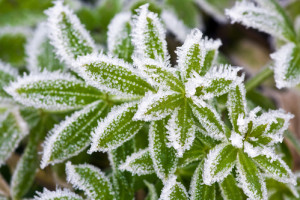Are you looking to get the most out of your garden year-round? The good news is that a lot of common shrubs, plants and flowers do well against frost in more intolerant hardiness zones.
So, what is a hardiness zone and how does it affect your winter gardening? A hardiness zone is a map put out by the USDA that basically tells gardeners which plants work best in which climates.
General Winter Gardening Tips
What’s important to realize upfront is that plants that can withstand the frost usually enter a period of relative dormancy to survive the winter months.
So, what are some things that you can do to make this transition easier on your hardy plants and perennials?
- Remove Waste
Removing any refuse, blackened-out stems and leaves from annual flowers is a great way to lessen the possibility of pathogens in the soil harming your hardy plants during their dormancy period.
- Install a Cold Frame
A cold frame (more on this below) is a raised wooden structure with a plastic cover that can further help protect perennials and hardy bulbs against the elements.
Even when plants are considered perennial, they still might benefit from the protection that a cold frame offers – especially if the temperatures drop to below zero with the wind chill.
- Apply Winter Mulch
On the topic of mulching, you should also realize that a lot of your summer mulch may have already decomposed at the start of winter.
Laying down a fresh layer of winter mulch goes a long way towards protecting your hardy plants and underlying soil during winter.
http://gardening.about.com/od/winterinthegarden/a/WInter_Mulch.htm
You can actually work with the elements by turning the fall’s fallen leaves into a winter mulch that will stay frozen and protect your garden.
Winter Gardening Devices to Consider
In addition to paying attention to your hardiness zone, devices like a quick-hoop system, floating row cover, or cold frame can greater buffer those punishing winter winds and cold temperatures.
- Quick-hoop system
Quick-hoop systems are also called low tunnel systems, and by whatever name these structures have been known to protect your plants from winter’s frost.
Annual and perennial hardy plants are able to survive the rigors of winter, frost and heavy winds. This means that calendula, foxglove, pansies and peonies require little maintenance during winter beyond the protection from a low tunnel system.
Hardy plants like these require less light to develop fully and can withstand hard frosts. Hardier plants only require around four hours of sunshine every day and grow best in cooler conditions.
If you’re living in an area that gets less frost, then many of these plants can be grown throughout the winter months. It’s recommended, though, that you plant hardy plants when the soil temperature is around 40 degrees fahrenheit – perhaps in very late winter or very early spring.
Low tunnels provide more protection against cold temperatures, frigid winter winds, and more relative humidity than the surrounding environment.
http://www.motherearthnews.com/organic-gardening/low-tunnels-quick-hoops-zmaz09onzraw.aspx
- Floating Row Cover
Floating row covers are probably the most simple and straightforward form of winter protection.
Putting your hardy plants under a thin film can protect against cold, harsh winds and potential hail damage while allowing an extended growing season for hardy plants and perennials.
- Cold Frame
The most popular kind of cold frame is a portable cold frame encased in wood with a durable plastic cover to protect against the elements.
That said, there are three types of cold frames (pictured here) that can extend your growing season well past frost. For more winter gardening tips, contact the professionals at Xeriscape today.
